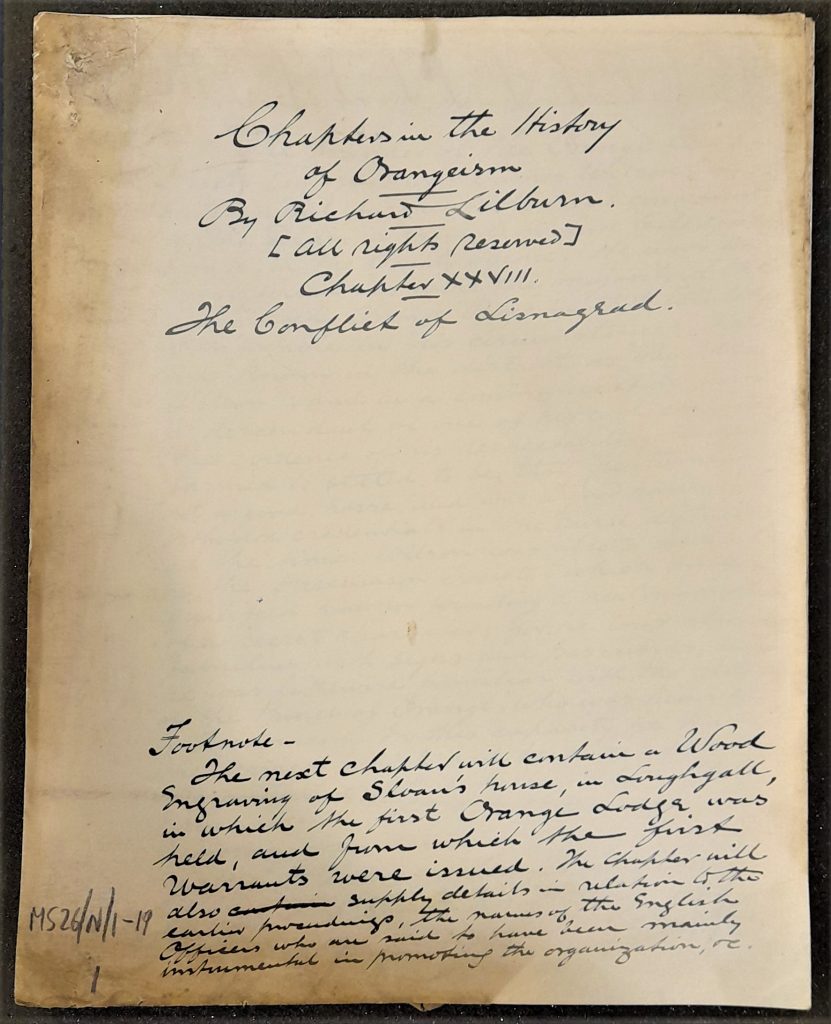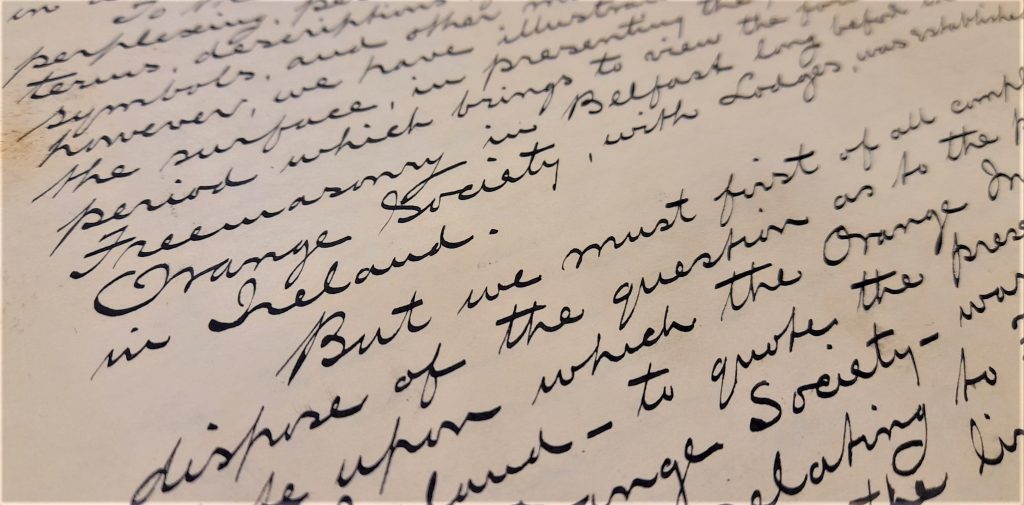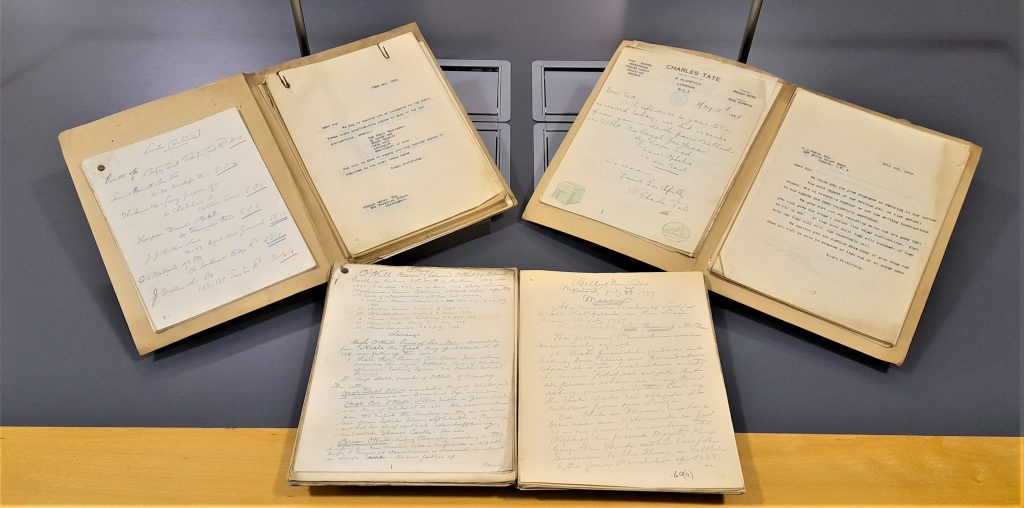Andrew Gibson: Jack of All Trades, Master of them All.
Andrew Gibson was born in the village of New Cumnock, Ayrshire, in south-west Scotland on 23 December 1841. He was the eldest son of William Kennedy Gibson, an agricultural labourer, and Janet Black, the daughter of William’s employer.[1] When the family moved to Pathhead, Andrew, and his brother Peter, worked as clerks in the local railway station. In 1859, Gibson’s mother died of tuberculosis. His father, William, then went on to marry Janet Lapraik. Lapraik was the granddaughter of John Lapraik, a good friend of the poet, Robert Burns (1759-1796).[2] Gibson spent his adolescence and young adulthood in Glasgow, living in the home of Duncan and Margaret Brown, and married the daughter of the house, Mary, in August 1869. The couple remained in Glasgow and had five children – Margaret (1871), Jessie (1872), Annie (1875), William (1876), and Duncan (1879).[3]
In the 1880s, Gibson was appointed as the agent for George and James Burns Ltd Steamship line. Gibson moved his young family to Belfast where they took up residence at 14 Cliftonville Avenue in north Belfast. Gibson’s responsibility was to all matters relating to the passengers and goods of the firm. Successful in his field, by 1910 Gibson was the largest agent in Belfast and was now working for both George and James Burns Ltd and the Cunard Steamship lines.[4]

Gibson was a man of many interests and talents. He became the President of Cliftonville Football Club[5] and then the Governor of the Belfast Library and Society for Promoting Knowledge, now known as the Linen Hall Library. It was here that Gibson greatly contributed to the cultural and social life of the people of Belfast by arranging the Belfast Harp festival in 1903, and the Belfast Shakespeare Festival in 1905. A proud adopted Ulster-Scots man, Gibson dove into the culture of the city, becoming the Office Bearer for the Belfast Scottish Association and the Belfast Benevolent Society of St Andrew. Gibson had a passion for poetry and literature, and finally became the Vice-President, rising to President, of the Belfast Burns Club, celebrating the works of Robert Burns. It is through his passion and interest in Robert Burns that led to Gibson becoming one of the most significant collectors of literary material in the whole of Ireland. Andrew Gibson “particularly wished to acquire every edition of Burns he could accrue and went to great lengths to do this.”[6] He spent twenty years building up a collection of Burns’s material, resulting in amassing a collection of over 728 editions of work. Gibson’s collection of Burns’s work received international fame and admiration, when, in 1896, Gibson lent 300 pieces of his collection to a Robert Burns exhibition in Glasgow.[7]
Gibson is remembered as an expert on poetry and bibliophile, but another area of his interest lay in the Freemasons of Ireland.
The Freemasonry Collection (MS 26) was part of the larger Gibson-Massie collection and was discovered when P.D. Massie purchased the derelict house of Gibson. Massie offered Queen’s University the opportunity to purchase the collection and requested the collection be referred to as the Gibson-Massie Collection. Queen’s University agreed and purchased the collection in May 1960. However, due to the scale of the Gibson-Massie collection and the numerous areas of strength, the collection was divided into its current three main areas:
- Gibson-Massie Collection (MS 37)
- Thomas Moore Book Collection (Moore prefix)
- Freemasonry Collection (MS 26)
The Freemasonry Collection is composed of handwritten notices (copies) of newspaper advertisements that call upon the Masonic Lodges (primarily of north Down and south Antrim). Taken from the four prominent newspapers of the era: Belfast Newsletter; Belfast Mercury; Belfast Evening Post; Northern Star. What is in the notices is extensive and diverse, ranging from: St John’s Day celebrations to Death notices of masonic brothers; the Building of Poor-Houses and the Linen Hall Library to Orangeism; and thanks to Reverends for their sermons to the increasing political situation of 1792, noting the resolutions of many of the lodges, declaring their support and loyalty to King George III, the Constitution, and the Civil Magistrates.

The collection sheds light into the daily life as a member of the Freemasons in the eighteenth century, along with how they conducted funerals, their political views – including their attitudes towards those seeking equal representation in the government – how they celebrated public holidays, what was being preached in their sermons, and the development of the economy, culture, and society in Ireland.
The collection then goes on to highlight Gibson’s passion for literature and the arts. Several sections are dedicated to the business of The Ballad Company, relating to their sales of songs; information of clients; and promoting the business of the company. MS 26 / AH is the largest section of the whole collection, and it is purely dedicated to Irish melodies. And to not forget his Scottish roots, there are also ‘Airs and Melodies familiar to the Highlands of Scotland’.
After a long, busy, and fulfilling life, at the age of 89, Andrew Gibson died on 23 June 1931,[8] leaving behind a collection and legacy that will continue to grow for generations to come.

Bibliography:
Discover Ulster-Scots. “1896: Centenary Evens and Andrew Gibson.” Accessed April 19, 2023, https://discoverulsterscots.com/language-literature/belfasts-bonnie-burns/1896-centenary-events-and-andrew-gibson
Murphy, James H., The Oxford History of the Irish Book: Volume IV | The Irish Book in English 1800-1891 (Oxford: Oxford University Press, 2011).
New Cumnock Heritage, “Andrew Gibson – Burns, Lapraik and the Irish Football Association”. Accessed April 26, 2023, https://newcumnockheritage.com/tag/andrew-gibson/
New Cumnock History, “Merkland and Andrew Gibson”. Accessed April 26, 2023, https://newcumnockhistory.com/key-historical-events/robert-burns/robert-burns-trail/merkalnd-and-andrew-gibson/
Royal Glasgow Institute of the Fine Arts, Memorial catalogue of the Burns exhibition: held in the galleries of the Royal Glasgow Institute of the Fine Arts 175 Sauchiehall Street Glasgow from 15th July till 31st October, 1896 (Glasgow: W. Hodge & Co, 1898).
The Linen Hall, Belfast. “Andrew Gibson: An Ardent Son.” Accessed April 14, 2023. https://www.linenhall.com/whats-on/online-exhibitions/andrew-gibson-an-ardent-son/ The Newsroom, “How Belfast’s Linen Hall Library got its Robert Burns collection for a song,” The News Letter, January 24, 2022, https://www.newsletter.co.uk/news/people/how-belfasts-linen-hall-library-got-its-robert-burns-collection-for-a-song
[1] “Merkland and Andrew Gibson,” New Cumnock History. Accessed April 26, 2023, https://newcumnockhistory.com/key-historical-events/robert-burns/robert-burns-trail/merkalnd-and-andrew-gibson/
[2] The Newsroom, “How Belfast’s Linen Hall Library got its Robert Burns collection for a song,” The News Letter, January 24, 2022, https://www.newsletter.co.uk/news/people/how-belfasts-linen-hall-library-got-its-robert-burns-collection-for-a-song-3538386
[3] “Andrew Gibson – Burns, Lapraik and the Irish Football Association,” New Cumnock Heritage. Accessed April 26, 2023, https://newcumnockheritage.com/tag/andrew-gibson/
[4] “Andrew Gibson: An Ardent Son,” The Linen Hall, Belfast. Accessed April 14, 2023. https://www.linenhall.com/whats-on/online-exhibitions/andrew-gibson-an-ardent-son/
[5] “1896: Centenary Evens and Andrew Gibson,” Discover Ulster-Scots. Accessed April 19, 2023, https://discoverulsterscots.com/language-literature/belfasts-bonnie-burns/1896-centenary-events-and-andrew-gibson
[6] James H. Murphy, The Oxford History of the Irish Book: Volume IV | The Irish Book in English 1800-1891 (Oxford: Oxford University Press, 2011), 429.
[7] Royal Glasgow Institute of the Fine Arts, Memorial catalogue of the Burns exhibition: held in the galleries of the Royal Glasgow Institute of the Fine Arts 175 Sauchiehall Street Glasgow from 15th July till 31st October, 1896 (Glasgow: W. Hodge & Co, 1898), 197.
[8] The Newsroom, “How Belfast’s Linen Hall Library got its Robert Burns collection for a song,” The News Letter .

